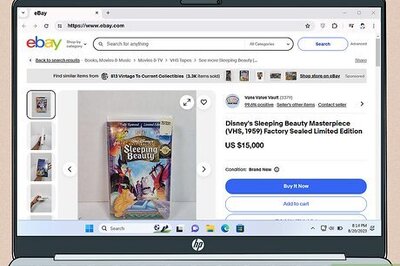
views
Differences Between Real and Fake Birkenstocks
Footbed logos All authentic Birkenstocks have logos printed on the footbed, which include the size of the shoe (the European size, total length, and US size), the foot width icon, “BIRKENSTOCK,” and “MADE IN GERMANY.” Some leather shoes also include a leather icon. If the shoes have soft footbeds, they’ll also have a “Soft footbed” logo (either on the heel in new models, or under “BIRKENSTOCK” in old models). If the shoes are vegan, they’ll also have “VEGAN” and a leaf icon on the heel. The font color depends on the type of footbed or shoe: Black font: Classic footbed (new models). Yellow font: Classic footbed (old models, prior to 2017). Blue font: Soft footbed. Green font: Vegan microfiber footbed. Gold or silver font: Some leather sandals (like the Madrid Big Buckle). Signs the shoes are fake: Icons are missing from the footbed. The color of the logos may be wrong and not match the type of footbed or shoe. The font may also appear wrong (too big/small, odd spacing) and poorly printed. There may also be spelling mistakes.
Midsole logo The inner edge of each Birkenstock shoe is imprinted with the “BIRKENSTOCK” logo. The logo is typically embossed into the side of the shoe where the material meets the midsole (the exact placement depends on the shoe model). It’s imprinted deeply into the material, making it easy to read and precise. Signs the shoes are fake: The “BIRKENSTOCK” logo is missing or on the wrong side of the shoes. The imprint may appear shallow and difficult to read. The font might also be too thin or thick, and the spacing may be off.
Upper material Birkenstock sandals and clogs are made out of lots of different materials, but the most common ones are leather (suede, nubuck, full grain), EVA plastic (ethylene vinyl acetate), and synthetic leather (called Birko-Flor, which only Birkenstock uses). Regardless of the material used, the upper is thick, soft, and has a high-quality look and feel. Signs the shoes are fake: The wrong material is used for the style of shoe (e.g., a leather style is obviously made out of plastic). Fakes typically use lower-quality materials, so they tend to look and feel less luxurious. The materials may be very thin and feel rough, too.
Footbed material Most Birkenstock shoes have footbeds that are made out of cork, which gives the shoes their comfortable cushioning and signature look. The cork has a slightly grainy texture and uniform look, with bits of lighter brown pieces amid the darker brown color. Signs the shoes are fake: The footbed is made out of plastic, often with a sponge or popcorn-like texture. The footbed might also look pebbled or appear the wrong shade of brown (too light, too dark, yellow, etc.).
Buckles and buttons Every buckle and/or button on authentic Birkenstock shoes is branded. The buckles either have “BIRKENSTOCK” or “BIRKEN” engraved on the bottom. All buttons have “BIRKENSTOCK” engraved around the circle with a dot between the “B” and the “K.” For the Gizeh model specifically, shoes sized 41 and up have “BIRKENSTOCK” on the buckle, while shoes sized 40 and under have “BIRKEN” on the buckle. Signs the shoes are fake: The buckles and buttons are missing the logo. The engraving might be shallow, hard to read, use the wrong font, appear too small or large, or be oddly spaced. Additionally, fake buckles and buttons often appear too shiny.
Straps Most Birkenstock sandals and clogs have straps that allow you to adjust the tightness of the shoe. The straps are made from the same material as the upper and are precisely cut. They also have a uniform thickness and a specific number of holes for adjusting the tightness. Signs the shoes are fake: The straps appear poorly cut (frayed edges or notches in the sides) and too thin or thick. There may be too many or too few holes in the straps, too.
Sole The soles of most Birkenstock shoes are made of EVA (a plastic material) that has a slight curve toward the footbed. The material is pressed with a diagonal, tessellating pattern that’s made out of curved hourglass shapes. There is a subtle “X” where the corners of each shape meet. Additionally, “Birk” is embossed inside every few shapes in a uniform pattern. Signs the shoes are fake: The shapes may appear too large or too small, and the “Birk” embossing might be missing throughout the pattern. The “X” at each corner often looks too prominent, too. The sole itself may also be very flat without a noticeable curve.
Box The current Birkenstock shoe box is a royal blue color with white lettering. “BIRKENSTOCK” is printed along the short side of the top, while the circular Birkenstock logo is printed half on the top and half on the side. Older boxes (prior to 2016) are white with navy blue detailing. It includes a feather logo, a keychain logo, and images of all their shoe designs. Signs the shoes are fake: The box might be the wrong color, and the logos may be placed in the wrong spots, be the wrong size, or use the wrong font. The wrong box might be used for the year the shoes were made (e.g., shoes made in 2025 come in the old white box). There may also be spelling and grammar mistakes.
Box sticker All authentic Birkenstocks have a sticker on the short side of the box that provides information about the shoes inside. This usually includes the model number, name of the shoe (e.g., Boston, Arizona), an image of the shoe, the shoe width, the shoe size, and the shoe color or pattern. Signs the shoes are fake: The sticker is missing any key information about the shoes. The information on the sticker might not match the details about the shoes, either (i.e., the sticker lists the wrong size, color, or shoe style). There may be spelling or grammar mistakes, too.
Smell Because a majority of Birkenstocks are made out of high-quality leather, they have a pleasant, earthy smell. Birkenstocks that are made out of synthetic materials (EVA, Birko-Flor) typically only have a very faint odor. Signs the shoes are fake: They have a harsh and strong plastic or chemical odor.
Color Birkenstocks come in all sorts of colors, from warm browns to cotton candy pinks. Regardless of the actual hue, the colors of authentic Birkenstocks are rich and deep. This gives them a high-quality look. Signs the shoes are fake: The colors appear dull or drab, or they look overly bright or garish. The colors used in fakes might also be off (too light or dark), or use completely different colors that the real shoes don’t come in.
Manufacturing country All of Birkenstock’s footbeds are made in Germany, while other parts of the shoe are produced in other countries around Europe. Birkenstock does not make their shoes in any other countries outside of the European Union. Signs the shoes are fake: They claim to be made in a country other than Germany or outside of the EU. For instance, any shoes that say they’re made in China are fake.
Manufacturing code All genuine Birkenstock shoes have a series of numbers and letters stamped on the footbed, typically under the “BIRKENSTOCK” logo. This is the batch code for the shoes that the manufacturer uses. However, the codes may not match on both shoes. Signs the shoes are fake: There is no manufacturing code stamped into the footbed. If there is one, it may appear poorly stamped and difficult to read.
Weight While Birkenstocks are comfortable and substantial shoes, they don’t actually weigh a lot. They’re very lightweight, so they’re not super noticeable while you’re wearing them. Signs the shoes are fake: They feel very heavy.
Price Prices vary depending on the style of the shoe and the materials used. In general, leather Birkenstocks cost around $100 and $150 while EVA Birkenstocks cost around $50. Sales and discounts are pretty uncommon, so the market price is typically what you pay. Of course, pre-owned Birkenstocks typically sell for less. Newer pairs without much wear-and-tear may sell for $20 cheaper, while well-worn pairs usually sell for much less. Signs the shoes are fake: A brand-new pair is going for much less than the market price. In general, if the price seems too good to be true, it likely is. For instance, a new pair of leather Gizeh sandals is very unlikely to be priced lower than $110.
Where to Buy Birkenstocks
Shop from Birkenstock or one of their authorized retailers. The best way to ensure your Birkenstocks are real is to get them at a Birkenstock store or to order them from Birkenstock’s website. The company also sells their shoes in lots of authorized stores, like Dillards, Dick’s Sporting Goods, and Journeys. If you’re shopping for pre-owned Birkenstocks on an online marketplace like Depop or eBay, look through the seller’s pictures carefully and compare them to real images of the shoes. Ensure the seller is highly rated and reviewed, too.
Avoid buying shoes from Amazon, Walmart, and stores like AliExpress. While Amazon does sell Birkenstock shoes on their website, Birkenstock does not list Amazon as an authorized retailer due to the large number of counterfeits that are sold. They also don’t sell their shoes at other major retailers, like Walmart, Sam’s Club, and Costco, so avoid these stores, too. Stay away from sites like AliExpress and DHGate as well, as they’re notorious for selling dupes.



















Comments
0 comment